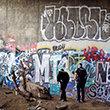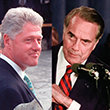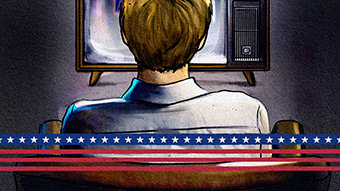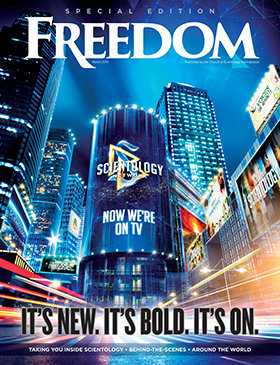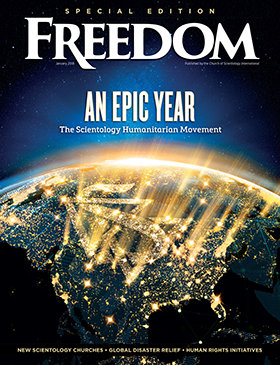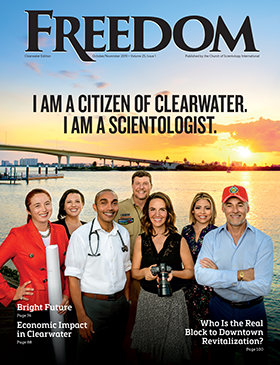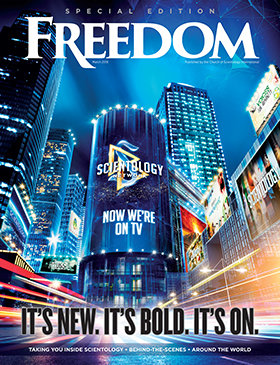
Here at Freedom, we don’t do politics. There are sources aplenty for everyone to get their own political fixes. We do, however, comment on the media in this space. And after what the United States endured during the least fact-based election in the country’s history, how can we not continue to observe, analyze, and critique the media’s complicity in poor journalistic practices—especially the ones we politely call “false equivalence” and “epistemic closure” (more on those in a minute). Then again, there is journalism’s relative helplessness in the face of the unprecedented explosion of content from internet sites that are under no obligation to be fair or represent actual facts instead of opinion masquerading as fact. On top of all that is yet another concept that has arrived like a deadly parasite in Americans’ political consciousness, “active measures.”
Media, the commercial type (so, emphatically, not this magazine, NPR, PBS or many other nonprofit outlets), has its own goals. Chief among them is generating revenue for their parent companies. We assume they are our watchdogs at our own peril. Yes, there was a fleeting moment, during and after World War II, when American media, led by Edward R. Murrow and CBS News, first on radio and then on television, reported courageously, countenanced no false equivalence, spoke truth to power, and even held the powerful accountable.
Before corporatism, and before corporate profits ruled in America, it was possible—not easy, not a given, and certainly not de rigueur, but possible—for media to rise to occasions that demanded scrutiny and action. Case in point is when some journalists risked their lives to write about a boisterous and conniving “populist” who rose to power in a devastated post World War I Germany by playing the victim and blaming not just his or his country’s, but the entire world’s problems, on the minority Jewish population.
William Paley, the founder of the Columbia Broadcasting System, or CBS, built a high wall between sales and news. He unleashed the coming legends of broadcast journalism, Fred Friendly, Ed Murrow, Walter Cronkite, Eric Sevareid and others, to report as they saw fit. They had earned his trust—and that of a grateful country—by risking their lives to bring WWII home to our newspapers and radios every day. It was post-war America and even though escapism was the order of the day in entertainment, he poured money into his news division, unconcerned with whether it ever made a profit. In fact, the idea that news could be a profit center was decades away.
It was CBS News that took on the powerful senator from Wisconsin, with the help of a special counsel for the army who, fed up with the paranoid assumption that there was a “Commie under every bed,” risked his career and quite probably his freedom when he asked during televised hearings, “Have you no sense of decency, sir, at long last?” Edward R. Murrow took up the gauntlet and using a primetime interview that turned our television sets into a national courtroom and made every citizen a juror, put a none-too-soon end to Senator Joseph McCarthy and his witch-hunt.
In the Watergate scandal, it was The Washington Post that took the risky stance. Editor Ben Bradlee and Publisher Katharine Graham decided that fully investigating the break-in and subsequent cover up were more important to the republic than either their social standing in the world’s littlest big city, or the paper’s profitability. With the Nixon Administration threatening them with IRS audits and zero-access to West Wing policymakers, the paper’s lifeblood, they held their ground and brought down an incautious, felonious administration that believed itself to be above the law.
For all the ballyhoo in the 2016 election, Fake News is not a new phenomenon. A century ago, it was called “yellow journalism” and was wielded by the big mainstream media purveyors of its day—newspapers. Most cite the efforts of the media moguls William Randolph Hearst and Joseph Pulitzer to commit American forces to what became the Spanish-American War. (Pulitzer, for his part, sought to make amends by establishing the ongoing awards for good journalism that still bear his name.)
Pulitzer and Hearst just wanted to sell papers and they both knew outrage equaled sales. So they ran unsubstantiated reports of barbarism, cruelty, torture and other acts of inhumanity, and attributed them to the Spanish, fanning the flames of controversy that led the Spaniards to abandon the hemisphere.
Anyone who thinks jaundiced journalism is a new phenomenon need only study that war, or stand in front of the newspaper boxes on any London street, where trumped-up stories have ruled the tabloids for a hundred years. Those tabloids allow readers to pick the news that suits their prejudices and world view. They’ve always been crazy, partisan rags, but their limited appeal, scope and availability rendered them fairly harmless.
Then came the internet, and suddenly, even the most outlandish ravings could have mass appeal, unlimited scope and ubiquitous availability.
The risks associated with today’s journalistic lapses are different because the noise level is so much higher. We are experiencing an unprecedented explosion of news content, thanks to the internet and subsequently, social media.
In days past, most communities had three TV stations and three or four radio stations to go along with a single major daily newspaper. Broadcasters, nervous that they might lose their FCC-granted license to use the public airwaves were careful to respect established standards of truth telling, including fact checking. Newspapers, for the most part, separated opinion from news, and considered themselves communitarian in nature: stewards of the public interest and well-being. Examples like that of the Hearst-Pulitzer war mongering stand out for their rarity in American journalism.
One of the manifest problems with the explosion of news and opinion content is that much of it is geared to appeal to the known leanings of its audience. Rather than present all the facts, hardcore partisans now ignore the news that doesn’t fit their world view, and only publish that which does. Academics call this “epistemic closure,” a fancy way of saying “closed mindedness.”
It is worse than the so-called “false equivalence” that also plagues contemporary journalism. False equivalence is what we get when a source makes a blatantly absurd (or occasionally, subtly absurd) and eminently disprovable statement, but the reporter, for reasons that may range from a basic lack of knowledge or preparation to a total breakdown of professional training in our journalism schools, feels duty-bound to give equivalent space to the flawed thinking or outright lie in an effort to preserve some sort of imagined journalistic balance. (“Interesting, Mr. Jones, please help me waste a few more column inches by explaining why the Sandy Hook Elementary School Massacre was a hoax staged by the supporters of more strict gun-access laws.”)
Epistemic closure is a different animal altogether. At its most frustrating, it is worse than false equivalence because it is a willful disregard of facts in favor of sentiment. It is a blatant way of saying, “The facts don’t fit my beliefs so I will either disregard them, or gin up some flimsy explanation to support my lies.”
Patricia Cohen in The New York Times gives a little history: “First used in this context by Julian Sanchez of the libertarian Cato Institute, the phrase ‘epistemic closure’ has been ricocheting among conservative publications and blogs as a high-toned abbreviation for ideological intolerance and misinformation. Conservative media, Mr. Sanchez wrote at juliansanchez.com—referring to outlets like Fox News and National Review and to talk-show stars like Rush Limbaugh, Mark R. Levin and Glenn Beck—have ‘become worryingly untethered from reality as the impetus to satisfy the demand for red meat overtakes any motivation to report accurately.’”
This whole business of fashioning our personal, impenetrable media silos that protect us from truths we’d rather not see, combined with the always-popular urge to kill the messenger, has left us in uncharted waters in the Digital Age.
Then we come to “active measures,” a term originally coined in the 1980s in the then Soviet Union. The KGB started pushing stories into the media that Ronald Reagan would push the world into war. The idea—planting false stories in the media to destabilize and demoralize opponents—was used by both American and Soviet spy outfits. But what has turbo-charged the concept is the internet. Cyberspace radically changed human history and enabled ideological and political propagandists to load up potent new digital “active measure” weapons (such as false stories that assaulted your computer screens during the campaign) including those from foreign interests who want to undermine America and the other Western democracies.
This whole business of fashioning our personal, impenetrable media silos that protect us from truths we’d rather not see, combined with the always-popular urge to kill the messenger, has left us in uncharted waters in the Digital Age.
In the now quaint previous eras—the Industrial Age, the Jet Age and the Space Age—the cost of media entry was high, and the government policed our airwaves, always on the lookout for liars, cheats and scoundrels. Access was limited to professionally trained broadcasters and journalists whose ethics were ingrained by professors and editors who learned and taught that truth is its own end. Not being attached to the outcome was the only way to approach a story.
It wasn’t perfect, and someone was always calling foul, but it served us pretty well for a pretty long time. After all, the coercive and deceptive use of words to move populations is a big responsibility, and in those bygone times, a reporter who purposely lied got discovered, shamed, fired and never worked again.
Like so many others, I welcomed this new Digital Age of open access via social media. I thought reducing the barriers to entry would mean a flourishing, well-balanced Citizens’ Media where ideas of merit competed in a brand new marketplace open to all. But, as is so often the case when technology races ahead of society, unintended consequences abound, and we find ourselves drowning in a sea of both well-intended if misinformed reporting, as well as plain old willful misdirection.
In a time when most Americans cannot name either of their senators, but unfailingly know all the McDonald’s dipping sauces, it falls on deaf ears to tell people they must now, by virtue of the low cost of entry to the internet, and its powerfully pernicious lies, become their own editors and read, watch and listen broadly as they carefully consider the sources of the information they consume.



